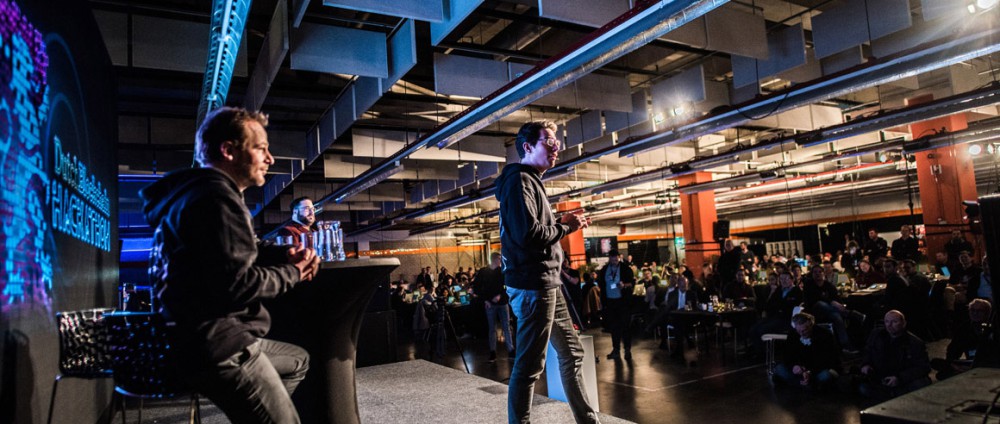Watson got to such an advanced state already that it’s now being used to answer questions for medical purposes
That's what an IBM employee told us before the presentation regarding Watson’s technology. In this process, Watson will answer medical questions by searching through a huge register of information. After analyzing all the information on the subject, Watson will prompt the answer that is most likely to be true. Until now, Watson is only being used as an advisory system, which means that it can only be used to confirm a diagnosis that was already given by a professional, and never to actually give a diagnosis. However, Watson’s technology can be used autonomously when it comes to tasks that are solely based on answering a question. But that’s enough on Watson for now, let’s talk Blockchain hackathons and IBM’s keynotes on how to win one!
What is a hackathon?
A hackathon is a multiple-day event of intensive collaborative programming where the participating teams compete to produce the best demo product within a specific given time. The idea is that instead of coming together for weekly meetings, like many established companies do, a hackathon facilitates more of a startup-like environment. In this, the teams work rigorously and continuously on complex problems to tackle them in one go. The Dutch Blockchain Hackathon of 2017 in Groningen was focused on incorporating Blockchain technology in practical societal issues that require innovative thinking. Every team participating had 48 hours to solve a societal issue in their category through the use of a Blockchain solution.
What is (a) blockchain?
Blockchain is generally associated with Bitcoins, but this is not necessarily the case. A Blockchain, in essence, is a distributed database that uses a distributed ledger to keep track of all data. This ledger can be seen as a logbook that stores and describes everything that happens in the Blockchain. A Blockchain does not use centralized servers to store the information, but distributes this among the entire network that makes use of the particular Blockchain. In this, Blockchains can be constructed both private and public.
Keynote IBM
During their keynote presentation, IBM revealed their strategy on how to win a hackathon. This year’s Blockchain hackathon in Groningen had five different tracks: “Identity,” “Future of Pensions,” “Energy,” “International Trade and Entrepreneurship,” and “Reinventing Government.” IBM participated in four of these tracks and won two of them. In the Identity track, the IBM team from Groningen wanted to create a way for refugees coming to Europe to prove their identity to big organizations like a government. Since numerous refugees lose their belongings during their travels, proving their identity upon arrival can be a difficult and troublesome problem.
To solve this issue, the IBM team created an app that uses Blockchain technology to store identity information. The app uses a biometric scan (a fingerprint scanner, for example) to access a user’s identity account. Users are able to upload personal data onto the account, which then can be verified by trusted parties such as The Red Cross. Since the Red Cross operates all over Europe, the role as verifier fits their organization perfectly. In this system, the users themselves will be able to decide who can access their data and who can verify it for them. As soon as the data is confirmed by a trusted party, it can be used by other organizations that would require such information. This app is a convenient solution for refugees that carry no proof of their identity, because this identity account is not physical and is always accessible via the Blockchain.
The main point that IBM's keynote relayed was the key question that their team kept on asking themselves throughout the hackathon: “What is the actual problem that we are trying to solve?” During the hackathon, IBM's team kept interacting with refugees that already have experience with the problem of identifying themselves. In addition, IBM’s team made clear that it is essential to have diversity within your hackathon team. This is the reason why they had built a team of both programmers and designers. Only programmers in a team would result in a working system, but one that is hard to actually navigate by its users; a team consisting solely of designers results in a system that is very user friendly in appearance, but lacks in effective functionality.

Reinventing Government track
During the Blockchain hackathon in February, the Rocket Minds team won the first prize in the “Reinventing Government” track. IBM also participated in this track, but was ultimately defeated by the Rocket Minds team. A victory over a multinational company such as IBM was a huge feather in our cap! Our team developed an idea that was geared toward the improvement of governmental registrations and the distribution of subsidies. Currently, this is an inefficient bureaucratic system that is easily subjected to fraud. As a solution, we developed a decentralized network based on Blockchain technology that consists of four voluntary parties: “the sponsor,” “the receiver,” “the validator,” and “the provider” (often the same party as the sponsor). Through this network, the receiver is granted a governmental registration or a subsidy by the 3 other parties sponsoring, validating, and, ultimately, supplying without actual money ever entering into the equation.
Do you want to know more about this concept and how it has further developed? Read the article below:
